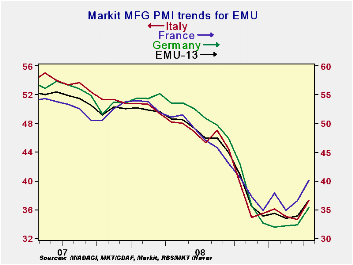 Global| May 04 2009
Global| May 04 2009Europe Begins to Cut Its Losses
Summary
Europe’s PMI readings bounced sharply in April across EMU nations. France made the second largest monthly rise at 3.59 points just above the UK’s 3.35 point gain. From its cycle low, the UK has made the greatest gain rising by 8 [...]

Europe’s PMI readings bounced sharply in April across EMU
nations. France made the second largest monthly rise at 3.59 points
just above the UK’s 3.35 point gain. From its cycle low, the UK has
made the greatest gain rising by 8 points with Spain and Austrian next
on gains of 6.1 and 5.9 points respectively from their cycle lows.
Italy has rebounded the least with a rise from its low reading of just
2.6 points. Looking at the levels of the indices in their respective
range of value they have occupied Italy is also the weakest followed by
Germany even though Italy’s raw MFG reading is higher than Germany’s.
These statistics show us that Europe is stirring from its lows
across countries. The UK and France are making the largest initial
moves, while Germany, the EMU’s largest economy, is one of the worst
laggards.
Just today the EU Commission has cut its outlook for growth in
EU this year, on Monday it revised lower its forecast for growth in the
European Union this year citing consumers reacting to the weakening
labor market and the slump in world trade as well as the effects of an
ongoing housing market correction. The commission, the executive arm of
the EU, presented its spring quarterly economic forecasts that
projected that gross domestic product in both the European Union and
the euro area would contract by 4 percent in 2009 and by 0.1 percent in
2010.
So amid signs that the EMU economy may have begun to
decelerate at a slower rate paving the way for an eventual upturn the
EU commission has unleashed a more pessimistic outlook.
| NTC/Markit MFG Indices | |||||||
|---|---|---|---|---|---|---|---|
| Apr-09 | Mar-09 | Feb-09 | 3-Mo | 6-Mo | 12-Mo | Percentile | |
| Euro-13 | 36.83 | 33.93 | 33.55 | 34.77 | 34.70 | 40.75 | 13.6% |
| Germany | 35.40 | 32.36 | 32.14 | 33.30 | 33.36 | 41.43 | 12.5% |
| France | 40.10 | 36.51 | 34.81 | 37.14 | 36.92 | 41.55 | 21.1% |
| Italy | 37.21 | 34.59 | 34.99 | 35.60 | 35.56 | 40.40 | 11.4% |
| Spain | 34.61 | 32.92 | 31.85 | 33.13 | 31.47 | 35.64 | 21.3% |
| Austria | 38.97 | 33.68 | 34.58 | 35.74 | 35.60 | 41.40 | 22.7% |
| Greece | 40.88 | 38.17 | 38.88 | 39.31 | 40.19 | 45.98 | 15.8% |
| Ireland | 36.10 | 35.12 | 33.20 | 34.81 | 36.39 | 39.99 | 13.1% |
| Netherlands | 38.76 | 35.92 | 35.47 | 36.72 | 37.26 | 43.12 | 13.5% |
| EU | |||||||
| UK | 42.85 | 39.50 | 34.93 | 39.09 | 37.34 | 40.69 | 37.2% |
| percentile is over range since March 2000 | |||||||
Robert Brusca
AuthorMore in Author Profile »Robert A. Brusca is Chief Economist of Fact and Opinion Economics, a consulting firm he founded in Manhattan. He has been an economist on Wall Street for over 25 years. He has visited central banking and large institutional clients in over 30 countries in his career as an economist. Mr. Brusca was a Divisional Research Chief at the Federal Reserve Bank of NY (Chief of the International Financial markets Division), a Fed Watcher at Irving Trust and Chief Economist at Nikko Securities International. He is widely quoted and appears in various media. Mr. Brusca holds an MA and Ph.D. in economics from Michigan State University and a BA in Economics from the University of Michigan. His research pursues his strong interests in non aligned policy economics as well as international economics. FAO Economics’ research targets investors to assist them in making better investment decisions in stocks, bonds and in a variety of international assets. The company does not manage money and has no conflicts in giving economic advice.






